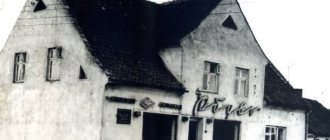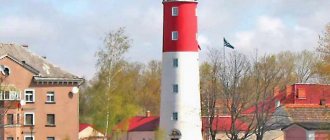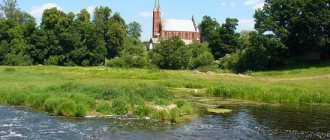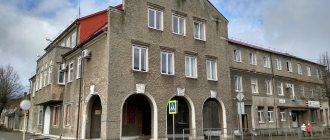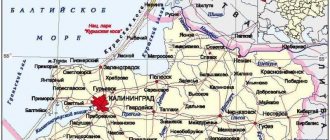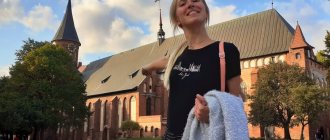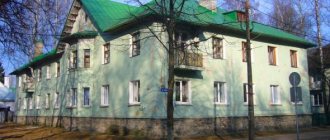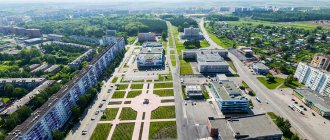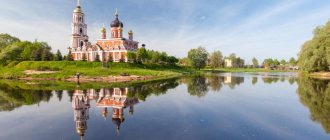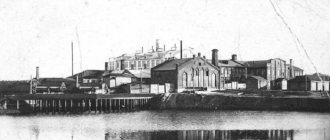About the history of the city
Along the Neman River in hoary antiquity lived tribes of the Skalvs, a Baltic nation that eventually dissolved into the Lithuanian nation. Their fortified capital was located on the site of the current city.
Opposite the Neman, on the other side of the river, there is Mount Rambinas - sacred to the Skalvi and some neighboring tribes. Ancient rituals have long been performed at its peak. Neo-pagans gather on Mount Rambynas even in our era.
Such a significant place attracted special attention from the crusaders advancing from the west. In 1277, they sailed on a small flotilla under the command of Dietrich von Liedelau, and the army of their vassals came from the upper reaches of the Neman, and after a bloody battle captured the pagan capital.
In its place, construction of the order's castle immediately began. This wooden fortress, built on the site of the Skalvi castle - a stronghold of militant Catholicism - was destroyed for several centuries by regular attacks by the Lithuanians. Until a powerful stone castle was erected in 1409, which survived and has survived to this day.
Ragnit Castle and the city of the same name became an important military center of East Prussia. In different historical eras, the Prussian king of Prussia, Friedrich Wilhelm I, and Swedish and Russian troops, and the hordes of Napoleon managed to visit it. The castle survived all the wars and, almost intact, together with the typical German town, became part of the Kaliningrad region after the Great Patriotic War.
During the years of the USSR, in the city of Neman, on the basis of a Prussian paper mill, one of the largest in the Soviet Union, the Neman Pulp and Paper Mill, grew up. The nearby state farms were by no means in poverty. Military units were located in the vicinity of the city.
With the collapse of the USSR, the pulp and paper mill went completely bankrupt, military units were disbanded, and the city of Neman plunged into a protracted depression. In 2010, construction of the Baltic Nuclear Power Plant began 12 km from the Neman, but in 2014 it was stopped and then completely abandoned. In 2022, the reactor vessel, originally intended for the Baltic NPP, was sent for installation at the Ostrovets NPP of the same type under construction in Belarus.
Active leisure in Neman
Fans of active recreation should not pass by the Neman sports complexes. These establishments have all the conditions to keep you fit and in good spirits.
Physical education and health
- Address: Pervomaiskaya st., 10.
The fitness and fitness center was opened in 2016. This is a modern, multifunctional complex, created with the latest technology and taking into account the preferences of the younger generation.
The complex includes a multi-purpose hall for playing football, volleyball and basketball, an open sports ground for mini-football and athletics. Exercise equipment is also installed outdoors.
Regional, federal and international football competitions are regularly held at the sports and sports complex. The Neman team has won tournaments more than once. On the ground floor you can see an exhibition of won prizes.
Boxing gym
- Address: Krasnoarmeyskaya street, 12a.
Boxing is one of the most popular sports in Neman. A battle hall has been opened on Krasnoarmeyskaya Street. There is both a training room with bags and a ring where tournaments are held. Both children and adults go to the boxing club. Visitors can order a master class from a trainer and take part in the training by renting a helmet and gloves.
City Stadium
- Address: Pervomaiskaya st., 10.
The Neman Stadium was founded during the Soviet Union and has educated more than one generation of sports fans. Despite its age, the stadium is in excellent condition and keeps up with modern times.
The complex includes a football field with high-quality turf, new sports equipment, gazebos and stands for fans. There is an alley of ancient trees and a walking trail around the stadium.
Training is regularly held on the football field and amateur teams are not allowed on it. However, other elements, including exercise equipment, are open for free use.
The main attraction of the city is the Ancient Castle Ragnit
The dimensions of the Ragnitsky castle are 58x58 meters, but visually it looks larger. The castle was a military base of the Teutonic Order for campaigns against Lithuania. The Lithuanians also gathered their strength and at least twice (1356 and 1365) destroyed what was then a wooden castle. It became stone on the eve of the Battle of Grunwald, after which the confrontation between the weakened Order and Lithuania began to subside. Largely thanks to this, the fortress has been well preserved for centuries.
The construction of the Ragnit fortress - stone instead of wood - began after the devastating raid of the Lithuanian army of Prince Keistutis in 1365. The construction manager was Konrad Zellner von Rottenstein. The castle walls were erected from 1399 to 1403. The overall construction of Ragnit Castle (with its internal buildings) was completed in 1409.
After the end of the Middle Ages, the fortress lost its military-strategic significance, and in the 19th century, a prison was built in the Ragnitsky castle; as well as city, district and military courts.
Ragnit Castle
During World War II, Ragnit Castle was heavily damaged by shelling and bombing. During the Soviet period, a market operated on the territory of the citadel and fairs were organized. Numerous and spacious rooms of the castle were adapted for storage purposes. Then the citadel was simply empty, destroyed and littered, along with the territory adjacent to it. Heat main pipes were laid along the historical brick façade of the castle.
In general, after joining the USSR, no one was going to maintain the old castle in good condition. Moreover: in 1976, for the filming of one of the scenes of the film “20 Days Without War” (director Alexey German, screenwriter Konstantin Simonov), some walls of the fortress were exploded, which further contributed to the accelerated destruction of the castle. The explosion took only a few seconds in the film, and as a result, one of the internal walls, thirty meters long, ten meters high, and up to two meters thick, was irretrievably lost.
In 1995, the film crew of the film “I am a Russian Soldier” (directed by Andrei Malyukov) again blew up part of the inner wall of the old castle, although on a smaller scale than in 1976.
Only in the 2010s did work begin to bring the old castle into relative order, with the goal of gradually turning it into an attractive tourist attraction.
Location: st. Victory.
Neman (ex Ragnit): not ours - don’t mind, blow it up to your heart’s content!
In the lower reaches of the great river, known to the Germans as Memel, to the Lithuanians as the Nemunas, and to the Russians as the Neman, there once lived the Skalvs, an ancient Baltic tribe. On the northern shore, now belonging to Lithuania, Mount Rambynas still stands today. Previously, there was a pagan sanctuary on its top. Not far from it, on the other side of the river, stood the capital of the Skalvs - Raganit Castle. In 1277 it was captured by the Teutonic Order and renamed Landeshut. This did not bring peace, on the contrary - the castle was repeatedly attacked, and by the end of the 14th century it was decided to rebuild it in stone, and, just in case, in a new place. The German name also did not catch on, so the fortification was named in the Prussian way - Ragnit.
Construction of the new castle was completed in 1409. For the next few centuries, Ragnit became a reliable northern outpost, first of the Teutonic Order, then of the Prussian Kingdom. Today the city again occupies a border position, being on the northern border of the Kaliningrad region.
Neman received its modern name in 1947. Initially, the option of renaming Ragnit to Suvorovsk was considered, but for some reason this decision was changed at the very last moment.
During Soviet times, the city did not suffer from poverty. The Neman Pulp and Paper Mill, which grew out of a German paper mill located in the city before the war, produced the best paper in the entire USSR. When the planned economy was replaced by a market economy, it turned out that no one needed the plant for nothing. For a little over twenty years it languished until it was finally ruined and sold for scrap.
Nowadays, Neman hangs by a thread from complete oblivion: there are no other industries here. Today the city is home to about ten thousand people. The only hotel in the city calls it “Neman”.
There we met with the rest of the participants in our trip, who had flown to the Kaliningrad region by plane. While everyone was having dinner, I got acquainted with the latest Neman news. It turned out that on the day of our arrival, “a local resident beat a friend to death with a shovel,” and the day before, “a 21-year-old man stabbed his girlfriend’s 44-year-old mother, wrapped the body in a sheet and hid it in the basement.”
The journey through the Kaliningrad region began very promisingly...
In 2012, when the “fight against Germanization” that had recently enveloped the entire Kaliningrad region was not yet in sight, a monument to the city’s patron saint, the Prussian Princess Ragnete, was erected on the central square of the Nemunas. According to an ancient legend, it was from her name that the name of the city appeared - Ragnit.
In general, there are several theories about where it comes from: from the Prussian rags, meaning “horn” or “cape,” to the Lithuanian ragana, translated as “witch” or “witch doctor.”
This is what the main city square looks like from a hotel room window.
In the inconspicuous courtyard adjacent to it there are some red brick ruins.
These are the ruins of that legendary Ragnit castle.
Before the war he looked like this. Don’t be surprised that the castle looks more like a huge palace: all the fortifications, once built by the Teutonic Order, were subsequently rebuilt several times, adapting to the new functions assigned to them.
So, from 1825 to 1945, there was a prison here, for the arrangement of which the vaulted ceilings of the second floor were demolished, and the huge Gothic windows to the full height of the walls were bricked up (source: ; author: unknown).
The fortification, which proudly stood for almost five and a half centuries and survived two world wars, could not cope with Soviet-Russian sloppiness. And if at the end of the 1940s the Ragnitsky castle was even more or less intact - part of its premises were used as warehouses, and fairs were held in the courtyard - then by the mid-1950s the destruction was obvious: the roof collapsed, and the walls were shamelessly actively disassembled by local residents for their own needs.
In 1976, for the sake of a nine-second scene in the film “Twenty Days Without War,” director Alexei German blew up one of the castle walls. Later, in 1995, pyrotechnicians worked in the castle again: the film “I am a Russian Soldier” about the defense of the Brest Fortress was filmed here. These two examples are very indicative; such an attitude towards historical heritage in the Kaliningrad region is in the order of things. The approach is purely occupier: it’s not ours, don’t mind, blow it up to your heart’s content!
Since 2010, Ragnitsky Castle belongs to the Russian Orthodox Church, which frankly does not know what to do with it. In essence, this is an awkward pile of ruins, the restoration of which to its original state is hardly possible (although I, of course, still believe in a miracle).
Above the ancient entrance arch, which in the past was covered by a lifting grille, some tattered pipes are barbarically attached directly to the six-hundred-year-old wall.
In photographs, the castle looks quite compact, but its external dimensions are almost 60 by 60 meters, the size of two hockey fields. The courtyard is square, 30 by 30 meters.
The fortification was four-story. Inside there were eleven large ceremonial halls and many smaller rooms for various purposes. The upper tier was crowned with a military move. An extensive network of basements was created underground.
Among the ruins that are dying out, even today you can see traces of its former greatness.
To the left is a traditional medieval toilet hanging over the outer wall. The Teutonic knights called him “danzker”, satirically relating him to the city of Danzig (now Gdansk), which in the 15th century left the Teutonic Order and came under the jurisdiction of Poland.
On the right are the remains of old in-wall chimneys.
Adjoining the castle on the western side was a fort, which was dismantled in the 18th century. All that has survived from it to this day is a twenty-five-meter watch tower, the only one of its kind in the entire Kaliningrad region. In the 19th century, the city clock was placed on it, and since then the name Clockwork has been assigned to it.
On the right side of the photo, some abandoned house is blackened by empty window sockets - a common subject for the Kaliningrad region. To the left is the renovated building of the city prosecutor's office.
One of the most beautiful Neman pre-war apartment buildings sticks out its whitish plastic double-glazed windows for everyone to see, like an artificial false jaw.
For example: before the war, the same house looked like this (source: Flickr; author: Bernhard Waldmann). Notice how elegant the windows were, especially the semicircular one on the front portico. Where is it now? Why is there a gaping hole instead of it?
But even through the veil of Russian shabbyness, the image of a cozy German town is still visible in Neman. The silhouette of the house, the outline of the pond - it’s amazing how everything was thought out, including from an aesthetic point of view. If only I could put all this in order, what a wonderful place it would turn out to be!
But for now there is some rubbish floating in the old mill pond. Local residents are quite happy with this state of affairs.
In the pre-war years, Ragnit was still thriving. The population was approximately the same as today's. The city had pulp and gas factories, brick factories, plywood production, an engineering factory, and a brewery. There was a river port.
One of the most famous pre-war buildings of the Neman is designated on all modern maps as a Mennonite church (read: Protestant pacifists). The official date of its construction is 1853.
According to another version, this building appeared only in 1939 as the party palace of the NSDAP (later recognized as criminal by the Nuremberg International Military Tribunal). Be that as it may, Nazi meetings were actually held here until the end of World War II. Here, for example, is a historical photo of that period (source: ; author: V. Gross).
This is how the building looks today.
From the outside it seems that it is made of stone. In fact, this is just a decoration, stylized as a medieval order church.
In Soviet times, the sports hall of the Neman Pulp and Paper Mill was located here. In memory of him, a rusty plaque has been preserved on the facade.
Today the building is abandoned. The roof has long since collapsed, and the inside is desolate. From time to time, in various circles of society, both Russian and German, the question of its complete demolition is raised as a former “hornet’s nest of fascists.”
Nearby there is a memory lane with a mass grave where Soviet soldiers who fell in the battles for East Prussia are buried.
Nine hundred meters from the Mennonite church is the village of Michurinsky. In fact, this is the outskirts of the Nemunas, known in pre-war times as Althof-Ragnit. Here in 1860, the German Baron von Mack built a magnificent estate. The house was surrounded by a dendrological park, in which there were over one and a half hundred rare trees and shrubs brought here from different parts of the globe. This is what the manor looked like in the 1920s (source: ; author: Johann Kegel).
After the war, the complex housed the board of the Michurinets state farm (from which the modern name of the village appeared). After the collapse of the Soviet Union, the agricultural enterprise naturally went bankrupt. The house, as well as the surrounding park with all its outbuildings, turned out to be of no use to anyone. In 2014, the estate burned down, and to date only charred walls remain.
Surprisingly, part of the dendrological collection that once belonged to Baron von Mack, by some miracle, albeit in a neglected state, has survived to this day.
In 2016, the estate complex, along with the land and all buildings, was auctioned for only 2.7 million rubles. True, the name of the current owner - LLC "City Cleaning Company" - leaves no hope that all this will ever be restored.
In the meantime, the state of the former baronial estate is very similar to agony.
The ambience is complemented by greetings from the Soviet era: the pedestal of the monument to the “leader of the world proletariat” that once stood here.
Exactly at the moment when we entered the territory of the estate, another fire was just dying out in one of its buildings - a former forge. On that day, the previously preserved tiled roof was completely destroyed.
Now the estate complex of outbuildings looks like this: on the left are the ruins of a forge, on the right are the ruins of a stable.
All basements are filled with a thick layer of garbage. This is another illustration of the attitude of local residents to the historical heritage of their region. As you can see, the level of culture is zero. Is this how you should treat your land???
Baron von Mack was known as a famous breeder of Trakehner horses, the most famous in East Prussia. A few kilometers from the baronial estate in the village of Kotelnikovo (formerly Neuhof-Ragnit), a complex of buildings of one of the baronial stud farms has been preserved.
Twenty years ago, its territory was purchased for production purposes by some businesswoman either from Lithuania or Poland. Everything ended as expected: they began to remove old German paving stones from the stud farm, and then completely dismantle the old buildings into bricks. Nowadays, what was managed to be defended is protected by several local residents, who have been waiting for years for the Kaliningrad authorities to finally pay attention to this place.
In Soviet times there was a military unit here.
Of the entire complex, only half of the buildings have survived today.
Inside, of course, there is devastation.
The only thing that still looks good is the stables. And there is still hope that they will someday be revived, as, for example, happened near Chernyakhovsk.
The story of Russian sloppiness and greed, which has reached incredible proportions in the Neman, will be incomplete without one very revealing episode. In 2002, a congress was held in Bad Fallingbostel, Germany, at which the German scientist Dr. Gerhard Scherreich solemnly presented the then head of the Neman region Sergei Lednev with knightly armor found before the war on the territory of the Ragnitsky castle, so that it would take an honorable place in the local history museum. Needless to say, this valuable artifact never made it to the museum, and now no one knows where this armor is...
Don't switch!
Continuation: Sovetsk (ex Tilsit) - the city of cheese, peace and empire
Park near the Mill Pond
Almost in the very center of the city of Neman there is a picturesque reservoir, which was formerly called Mühlenteich (Mill Pond). This lake is rightfully considered the best place for cultural recreation in the entire city of Neman.
On the shore of this pond there is a beautiful park, and on its outskirts stands the Church of the Holy New Martyrs and Confessors of Russia. There is a pedestrian area leading to this beautiful church. In our time, this territory has been completely reconstructed as part of the Small Towns and Historical Settlements program.
Park near the Mill Pond
A lot of new things have appeared in the beautiful and old park. Including a rope park and two stations for boats and catamarans. The park also has a rich collection of small sculptures depicting all kinds of fairy-tale and cartoon characters. This is a real haven for children!
The picturesque nature of the Neman surroundings
Tourists love the green corners of the Neman: wild natural spaces, ancient parks and well-groomed squares where you can stroll, enjoying the fresh air and birdsong.
Lake Ragnitskoye
- Coordinates: 55.038865, 22.012720.
On the outskirts of the city splashes the most beautiful lake of the Neman - Ragnitskoye. There are no tourist complexes here, only the beauty and tranquility of nature. The lake is small and surrounded by a mixed grove where townspeople pick berries and mushrooms. Fishermen often come to the lake. Small pike, perch and crucian carp are found here.
The lake is interesting from an archaeological point of view. Encampments of ancient people have been discovered on its banks. The artifacts found (tools, jewelry, amulets, ceramics) can be seen in the city history museum.
Mill Pond (City Pond)
- Address: 55.038541, 22.025087.
The mill pond is one of the most picturesque places in the Neman. Along its banks there are parks surrounded by greenery. Paths are laid through the mixed groves: paved and ecological. Tourists relax in gazebos and on cozy benches under the treetops.
One area is not like another. Somewhere flower beds are blooming and log bridges span streams, and somewhere nature lives a free life, letting go of thickets and flowering shrubs.
Most often, tourists visit parks near the lake during the day. There are cafes nearby, and the parks themselves have playgrounds where children can play to their heart's content. In the evening, a chain of lanterns is lit along the shores of the lake, which gives it a magical and festive look.
Orthodox Park
Photo: © https://goo.gl/maps/VCoMYCnEmk64LHQm9
- Address: Kalinina street.
Orthodox Park is a mysterious and slightly gloomy area. It is located in the middle of a wild birch grove. There are no paved paths here, only paths laid by mushroom pickers.
The park is located near the brick church, which is under restoration. This is an ancient building with a hipped bell tower, gables and attics. Its roofs have already been replaced with new ones, but the walls still bear traces of destruction.
Mother and Child Park
- Address: Shkolny Lane.
In the middle of a residential area stands a sculpture of a young woman. With one hand she presses the child to her chest, and with the other she raises it to the sky and holds a bird in her palm. There is a small park around the sculpture, where mothers with strollers often relax.
Well-groomed paths stretch along the lawn with decorative fir trees. This park was created as a tribute to caring mothers and serves the purpose of bringing children closer to their parents.
Health Park
- Address: Pobeda Street.
Zdravia Park is one of the oldest parks in the Neman. It was created in the 1950s to attract young people to a healthy lifestyle. The park regularly hosted sports competitions, health days, mass exercises and games for schoolchildren. The grounds were decorated with sculptures of muscular athletes and agile, cheerful pioneers.
Currently, the park has ceased to be a center of sports life. Now it’s just a green corner where it’s nice to stroll. The main attractions of the park are wicker gazebos for relaxation and birdhouses to which birds flock.
Don't miss: Sights of Kaliningrad
Art School Park
Photo: © https://goo.gl/maps/stqcNPavudWfkPyX8
- Address: Sovetskaya, 10-14.
The park of the art school is not distinguished by its colorful flower beds, fountains, or sculptures of great artists, but there are dark wood gazebos standing in the center of the lawns.
These gazebos have round tables where you can sit, drink coffee bought from a nearby coffee shop, chat with friends, or work alone on your own poems and drawings.
Fire Pond
- Address: Krasnaya street.
The fire pond is a tiny body of water that has existed since time immemorial. It got its name back in the days when wooden huts stood around it.
Candles and stoves often caused fires, and water was dragged from the pond to extinguish the flames. In addition, children swam in the pond on hot days.
Gradually the pond becomes overgrown and becomes smaller. Today you can see wild ducks and waders there. A willow tree, as old as the pond itself, leaned on the shore.
See also the sights of other cities of the Kaliningrad region - Gvardeysk, Svetlogorsk, Pravdinsk, Chernyakhovsk, Gusev, Sovetsk, Yantarny, Zelenogradsk and Baltiysk
Neman has retained the features of a city of knights, brave warriors and fairy-tale princesses. Its castles and ruins transport tourists to the legends and tales they read about in books. The magical atmosphere and spirit of antiquity are remembered for a long time and encourage you to return again and again.
Mennonite Church – NSDAP Palace – Sports Hall
At the entrance to the Neman from the city of Sovetsk there is a curious three-story building, which was built by members of the Protestant Mennonite community from the city of Ragnit. The volume-spatial composition is made up of a rectangular structure of 5 volumes: the main structure with a gable roof and 4 rectangular structures with flat roofs located in the corners.
This building, called the "Community House", was erected from brick in 1853 and faced with stone. It measures 38.42 by 20.65 meters. Then the Mennonites sold it to municipal authorities. During the reign of Hitler, it housed the Palace of the local branch of the National Socialist Party (“Partaiburg”).
Mennonite Church – NSDAP Palace – Sports Hall
The building survived the Second World War, after which it was used as a gym for many years. Until in 2006 a strong fire completely destroyed its roof. After this incident, the historical building remains empty and quickly deteriorates.
In 2007, by decree of the regional government, the church received the status of a cultural heritage site of local (municipal) significance. However, restoration and restoration were not started after this.
Address: st. Pobeda, 27.
TOP 3 - the most interesting places in the Neman
Among the many attractions of the Neman, its “calling cards” stand out especially clearly. These places made the city famous and attractive to tourists.
Ragnit Castle
- Address: Pobeda Street.
In 1277, the wooden fortress of Ragnit, which gave the city its first name, was burned by the troops of the Teutonic Order, and Landmaster Meinhard von Querfurt founded a new well-fortified fortress in its place. In subsequent centuries, powerful walls protected the city from the Lithuanians and were rebuilt many times.
In 1409, the construction of the main castle of the fortress was completed. The monumental building was built to last for centuries. It was decorated with openwork gates and carved stone. The clock tower became the famous symbol of the castle. It had six tiers and ended with a gable with through holes. On the top tier there was a clock, which, unfortunately, has been lost.
In 1825, the castle ceased to serve as a defensive fortification and housed a prison. In the same decade, there was a severe fire that caused irreparable damage to the fortress. In 1933, the Nazis took possession of the castle, placing it as a prison for anti-fascists.
During the Great Patriotic War, the castle was significantly damaged and was abandoned for a long time. The castle experienced its next major destruction during the filming of the film “20 Days Without War,” when director Alexei German exploded the interior walls. Subsequently, this experience was repeatedly repeated by other filmmakers.
Currently, restoration work is underway on the territory of the destroyed castle, organized by volunteers. The attraction also offers excursions, photo sessions and themed events. Despite its decline, the castle attracts tourists like moths.
Mennonite Church
- Address: st. Pobeda, 27.
The Mennonite church (a branch of Protestantism) was erected in 1853. This is a Gothic stone building with a sharp gable, pointed arcades and massive portals.
Every element of this structure evokes thoughts of medieval castles. During the Great Patriotic War, the church was occupied by the National Socialist German Workers' Party. There are rumors that anti-fascist Ernst Thälmann, who was serving a sentence in the Ragnit castle prison, was severely tortured in the church’s dungeon. In the post-war years, a gym was located in the former temple.
In 2001, the church received the status of a cultural heritage site and became the property of the governor. Since 2013, restoration work has been underway in the building.
Neman River
- Coordinates on the map: 55.039577, 22.038511.
The Neman River united three countries: Lithuania, Belarus and Russia. Along its banks there are ancient cities, ancient churches and churches, and relict forests rustle with leaves. It is along the river that the border between Russia and Lithuania passes. While walking along the coast, residents and guests of the Neman can see Rambynas Regional Park.
Rafting on the river is organized on kayaks, motorboats and rowing boats. This is a great opportunity to explore the embankments' sights and natural beauty. Translated from Finnish, the word niemi means “chain of hills”. Traveling by boat along the Neman, tourists will admire this heritage of the great river.
Evangelical church Ragnita
The church in the city of Ragnit was built in 1517. It was a building in the Gothic style, the windows of which were made with pointed arches, and the tower was made of unpolished stone. When the secularization of the Teutonic Order occurred, the church became evangelical. In 1549-1563, Martynas Mazvydas, a Lithuanian writer and pioneer printer, compiler and publisher of the first book “Catechism” in the Lithuanian language, served as its pastor. On the north-eastern wall of the tower of the former church there is a memorial plaque in his honor.
Evangelical church Ragnita
In 1757, during the Seven Years' War between Russia and Prussia, the church was destroyed. But instead of it, a new one was built in 1771. In 1853, a huge tower 35 meters high was added to the church. In the 1960s, when the church building was rebuilt, the tower was demolished to the height of the main building.
Address: st. Oktyabrskaya, 9.
Improvement
It is known that in 2022, the Neman city authorities won the All-Russian competition for projects to create a comfortable urban environment and received a federal grant of 45 million rubles. But the funds received were not used for the reconstruction of the fortress. They will be used to improve the area around it and to restore the observation tower, which restorers eventually want to turn into an observation deck.
They plan to install a tourist information center near the Ragnitsky castle and promise to equip a special bicycle route.
Brick walls, ©
Together with the city administration, the entrepreneur hopes to improve the Daubas tourist trail, which leads from the fortress to “Lithuanian Switzerland.” This is what the locals call the hilly area in the area of the current village of Bolshoye Selo. On the other side of the Neman, Artyukh set up the guest house “Old Beekeeper’s Farm”. Together with it, a cheese factory, a restaurant and the Ragnitsky castle, a tourist complex should be formed, according to the businessman, which will become a new city-forming enterprise, as the pulp and paper plant was previously considered here.
It is known that during the initial clearance of the garbage, a curious find was discovered - bricks from the castle with a distinctive mark that vaguely resembled the Latin letter S. But according to the castle keeper, upon a detailed examination it became clear that the symbol looked more like the letter R.
Panorama of Ragnit Castle on Yandex map
Ensemble of buildings of the agricultural school
A complex of agricultural school buildings was built in the city of Ragnite at the beginning of the 20th century: one educational building, northeastern - in 1901, and the other, southwestern - in 1914.
The first educational building is a 2-story building with an attic floor in the eclectic architectural style, with a gable roof covered with ceramic corrugated tiles. The building is used for its intended purpose - it houses secondary school No. 2 of the city of Neman. The second academic building is also a two-story building with an attic floor and projections in the Art Nouveau style, with a half-hipped and gable roof.
Ensemble of buildings of the agricultural school
The ensemble of buildings of the agricultural school is included in the unified state register of objects of cultural heritage of the peoples of the Russian Federation, as an object of cultural heritage of regional significance.
Address: st. Oktyabrskaya, 17; st. Sovetskaya, 17.
Ancient architecture of the city of Neman
The first impression of Neman is formed by its appearance. Ancient buildings, mansions, majestic towers - thanks to these features, tourists fall in love with the city at first sight.
Manor von Mack (Althof Ragnit)
- Address: Nemansky district, Michurinsky village.
On the outskirts of the Neman stands an abandoned manor complex of the 19th century. Its main building is a brick mansion with a tower. It is in disrepair, but many of its elements have survived. A wide staircase leads to the decaying wooden doors.
Inside, the window shutters, paint and plaster have been preserved. A long hallway leads to a bay window with a row of windows overlooking a leafy grove. This was once a magnificent park with a pond. On the façade of the building, forged decorative elements have been preserved, as well as stucco molding and elegant pilasters with capitals. Next to the mansion there are small brick outbuildings that served as outbuildings. Inside they also preserved wooden and forged decorative elements.
The complex is under state protection and is private property. Due to severe destruction, the buildings cannot be restored and simply smolder in the ancient grove, like ghost houses.
Former German bakery
- Address: Sovetskaya street.
The corner building consists of two rectangular buildings united by a central half-tower. It was built at the beginning of the 20th century and belonged to the family of Ragnite bakers.
In the museum you can see black and white photographs in which the building is still completely new, and the Backerei sign hangs above its veranda. The bakery operated until the 1930s, after which a hostel settled in the building. Today there are also residential apartments here.
Water tower
- Address: Pobeda Street.
The water tower was built in 1903. For a long time it was the high-rise dominant of the city. The stone structure has a round shape, the upper tier is slightly wider and trimmed with wood. An ancient staircase leads to it, which is closed from the curious.
In the past, the tower supplied clean water to the surrounding areas, but now it is not used, but has the status of an architectural monument. Despite its ordinary appearance, it is known among tourists and townspeople as one of the most recognizable landmarks.
Ensemble of buildings of the agricultural school
- Address: Sovetskaya st., 17.
The agricultural school was founded at the beginning of the 20th century. From 1903 to 1914 Buildings in eclectic and modernist styles were erected on the territory: educational buildings, dormitories. The buildings are a two-story building with an attic and a roof covered with corrugated tiles.
Between the windows of the second and attic floors you can see the original stucco medallions. Today the building is occupied by secondary school No. 2. The ensemble is recognized as an object of cultural heritage of regional significance.
Old German house
- Address: Pobeda Street, 99.
An interesting building is located at st. Pobeda, 99. A stone two-story mansion built in the mid-19th century attracts attention with its unique architecture in the Baroque style. Garlands and whitewashed frames have been preserved on the window niches.
The central part of the building ends with an attic with a pediment; in its center there is a medallion, blackened by time. The tetrahedral bay windows and protruding rustication add variety to the correct form. The building is included in the Neman cultural heritage list.
Restaurant Deutsches Haus (“German House”)
- Address: st. Pobeda, 51A.
“German House” is the oldest restaurant in the Kaliningrad region, which was opened in 1792. For centuries, the best culinary specialists have worked there.
Today people come here to taste delicious Russian and European cuisine, as well as East Prussian dishes prepared according to ancient recipes. The restaurant attracts tourists not only with delicious lunches, but also with cheese-making master classes and Tilsit-Ragnit cheese tastings.
Currently, the restaurant occupies the same building in which it was opened more than two centuries ago. This is a brick building in the style of German provincial architecture.
German stucco
- Address: Zheleznodorozhny Lane.
Separated from the wide Zheleznodorozhny Lane is the narrow Sovetskaya Street. In its nook, old European buildings have been preserved. Stone houses are located very close to each other. One of these houses is a truly unique and priceless architectural monument and an important landmark.
The massive crossbars of the doorway are decorated with antique German stucco. Here you can see geometric, floral patterns, as well as images of a grazing bull, a fisherman in a boat and a deer hunter. Fishing, cattle breeding and hunting were the main sources of food in East Prussia in the 18th-19th centuries.
Bismarck Tower
- Coordinates: 55.020136, 22.115280.
The Bismarck Tower is a stone structure that was erected in several cities of the Kaliningrad region in memory of Otto Bismarck. As you know, thanks to him the unification of Germany took place. One of the surviving monuments is located in the village of Garino, not far from the Neman.
A dilapidated tower rises in the middle of a birch grove. Its austere silhouette has decayed, the smooth stone surface has become porous and has collapsed in several places. Only the top tier remained more or less untouched. Window openings are still visible on the first tier. The entrance is boarded up, as entering the tower is dangerous to life.
Church of the Holy New Martyrs and Confessors of Russia
The Church of the New Martyrs and Confessors of the Russian Church was founded in 1993, and consecrated in the summer of 2001 by Metropolitan Kirill of Kaliningrad and Smolensk. The total area of the temple is 100 square meters. It is distinguished by its original architecture, which continues Western European traditions, and proves the possibility of combining the historical architectural traditions of Prussia and Russia.
Church of the Holy New Martyrs and Confessors of Russia
Above the entrance rises a 30-meter, three-tier, square bell tower with arched windows. In the second tier of this bell tower, in a niche, there is a life-size icon of Christ the Savior. There is one onion dome above the roof of the nave and above the altar.
Address: st. Kalinina, 12.
District hospital building
The building of the district hospital, designed in the architectural style of “historicism”, was built in the city of Ragnit at the end of the 19th century.
District hospital building
It is a two-story building, elongated from northwest to southeast, with a central and two corner projections and a steep gable roof.
Address: st. Pobeda, 25a.
Vocational school building
The vocational school building was erected in the city of Ragnit in 1930. It is a two-story rectangular building made of fired ceramic bricks on lime-sand mortar with a hip roof, which is covered with wavy ceramic tiles of the Dutch type.
Vocational school building
Since 2016, the vocational school building has been included in the unified state register of cultural heritage sites as an object of cultural heritage of regional significance.
Address: st. Sovetskaya, 19.
City school building
This school building, designed in the neoclassical style, was built in the city of Ragnit in 1903. It is a two-story, rectangular building with an attic floor, a projection in the center of the south-eastern facade and a steep gable roof. The walls of the building are made of fired ceramic bricks on lime-sand mortar under plaster.
City school building
Nowadays, this building, recognized as a historical and cultural monument of a regional scale, is used for its intended purpose - as a school.
Address: st. Oktyabrskaya, 15.
New gate
More recently, new entourage gates, stylized as the gates of a Teutonic castle, were installed in Ragnit. This is a fence with an antique lock and weighs 1.5 tons, made of natural oak and fastened with a metal lattice.
Now all that remains is to make a fortification, landscape the area in front of the castle and close access to the walls with a special mesh. This must be done, since at the moment there is still a danger of individual bricks falling.
The improvement work on the attraction is planned to be completed by May 2022. Then, in a solemn atmosphere, the castle gates will open and give its visitors a medieval atmosphere. The restorer’s plans include holding a knight’s tournament, a crafts fair and a carnival here. It is planned to hold not only city holidays, but also private events in the fortress itself.
©
Mass grave of Soviet soldiers
Next to the building of the former sports hall there is a mass grave of Soviet soldiers and a sculpture of a soldier. This monument was erected in 1948. More than ninety Soviet soldiers who died in Ragnit and its environs during the fighting of the Great Patriotic War are buried in a mass grave.
Mass grave of Soviet soldiers
Location: square on Pobeda Street.
War memorials and monuments of the Neman
The proud and sorrowful history of the battles on the Neman land is reflected in numerous memorials. They preserve the memory of wars and soldiers of different times.
Monument to the soldiers of the First World War
- Address: st. Victory.
In 1924, the residents of Ragnit raised funds to create a monument in honor of the soldiers who died on the battlefields of the First World War. The famous German sculptor Hermann Brachert carved a rectangular slab from stone. On one side he carved a high relief depicting three brothers leaving for the front, and their mother bowing her head in prayer.
On the other side there is a quatrain in German: “The fruits are full of male strength, Having ripened on the tree of life. We fell in the storm of struggle, Was this sowing in vain?
In 1945, the monument was demolished. The stone slab remained abandoned and slowly sank into the ground. In 1990, volunteers raised the monument from the ground. After restoration, the stone slab was placed on a concrete podium with a chain link fence. A bronze plaque with a translation of the poem into Russian was installed at the base.
Mass grave of Soviet soldiers who died during the Great Patriotic War
- Address: Pobeda Street.
During the Second World War, a mass grave of soldiers who died in battles on the territory of Ragnit was formed behind the Mennonite church. Later, soldiers who died from wounds in hospitals were buried in a mass grave.
In 1948, a monument was erected at the burial site. It is a bronze sculpture of a soldier kneeling on the grave of his comrades. At the foot there is an inclined pedestal lined with black marble. There are plates on it, on which you can read 90 names of fallen soldiers. In 2003, restoration took place on the territory of the mass grave.
The area in front of the monument was re-tiled and surrounded by a cast-iron fence. Students from Neman schools planted a leafy alley. Since then, flower-laying ceremonies and solemn rallies in honor of the Victory have been held annually at the burial site.
Monument to the Border Guards of the Special Forces Detachment
- Address: Victory Street square.
The monument is dedicated to the Neman border guards who were sent to the Caucasus in 1995-1996 and died during the Chechen campaign. The monument is a black slab of irregular shape.
The Caucasus Mountains, a border pillar and the names of dead border guards are engraved on it. The area around the monument is lined with bricks and fenced with cast iron posts with chains. There are always fresh flowers at the foot of the stove.
Monument to Internationalist Soldiers
- Address: Victory Street square.
A black granite stele was installed in Victory Square. A five-pointed star framed by a laurel branch is engraved on its smooth surface. The base is lined with dark slabs, in the center of which is a memorial plaque with the inscription: “Only the Motherland will never condemn us. We are her living and fallen sons.”
Underground bunker
- Address: Molodezhnaya street.
Since the Great Patriotic War, an underground bunker has been preserved in the Neman, which served as shelter during bombing hours. The entrance is a reinforced concrete box that merges with a small embankment.
Inside, brickwork, stone steps, narrow openings and supporting vaults have been preserved. The bunker is gradually being destroyed, so tourists are not recommended to go deep into this attraction.
Monument to those killed during the First World War
Monument to those killed during the First World War of 1914-1918. was installed in Ragnit in 1924, on the eve of the anniversary of the beginning of the First World War with donations from the residents of Ragnit in the park near the church, and after 1945 it was demolished. However, in 1991 this monument was restored.
It is a 2 x 2 meter concrete slab mounted vertically on a stepped base, with a bas-relief by Herman Brachert. He depicted three soldiers and a woman accompanying them. On the reverse side there is an inscription in German that asks: “Men full of strength and life died in the fire of battle. Was this sowing in vain? The territory of the monument, with an area of 6 square meters, is fenced with a chain on concrete pillars.
Monument to those killed during the First World War
In 2007, this monument was given the status of a cultural heritage site of local (municipal) significance.
Location: square on Pobeda Street.
Prussian Princess Ragneta
In 2012, on City Day, a bronze sculpture of the Skalvo princess Ragneta (or Ragaina) was installed on the Central Square of the city of Neman. According to legend, the village of Ragnet owed its name to the ancient Prussian princess Ragnet.
According to legend, it gave rise to the Skalv tribe. Ragaina was the daughter of a giant who descended to Earth from the Star. At the request of her father and of her own free will, the princess decided to throw in her lot with the most worthy man alive. To do this, she locked herself in a high castle, and threw the magic key to it on the road. Many people passed by the castle, but no one was given the wonderful key.
Prussian Princess Ragneta
But one day he was raised by a strong, brave and noble young man Sklava, whom the beautiful Ragneta-Ragaina fell in love with. From that time on, the Sklavin princes became the owners of the castle and the entire Neman valley.
Her sculpture was created according to the design of the staff of the Neman House of Culture and made by master Andrey Shevtsov. The height of the statue exceeds two meters, and its weight is three hundred kilograms. The sculpture is installed on a granite boulder, on the front side of which a bronze lock is mounted. And in front of the sculpture there is a bronze key on the ground. The surrounding area is paved with tiles.
Location: Central Square, st. Victory.
Cultural recreation in Neman
Museums and theaters will help you get acquainted with the culture and history of the Neman. Fascinating exhibitions, colorful performances - all this will not leave tourists indifferent.
Museum of the History of the Neman Region
- Address: Sovetskaya st., 23.
The museum introduces tourists to the history of the Neman and its surroundings, from ancient times to modern times. The museum has several halls, each of which is dedicated to a different topic. The most interesting of them:
- "Archeology". Here are presented bronze, bone, stone and ceramic products discovered at the sites of ancient people.
- "The First and Second World Wars." In the halls you can see weapons, uniforms, documentary photographs and personal belongings of soldiers. Also in this hall, tourists will learn the history of the monuments that were erected in the Neman in memory of their fallen fellow countrymen.
- "Patriotic War of 1812". The most interesting exhibits are cannonball fragments, cartridges and other finds from battle sites, as well as a copy of military uniforms.
The museum regularly hosts interactive events for children and teenagers: master classes, meetings with local historians and poets, military-patriotic holidays.
Cinema hall "Neman" (House of Culture)
- Address: Sovetskaya st., 2.
The Neman House of Culture differs from similar institutions in other cities. The main part of the entertainment program here is not performances and concerts, but film shows. The center of the complex is a hall with a large screen and a comfortable environment.
Here viewers can watch the latest in world cinema or spend time watching old domestic films. Thematic sessions are accompanied by lectures and communication with people of different specialties.
In addition to sessions, Neman organizes excursions to the city’s attractions, performances in open areas and in concert halls. On its basis there are educational children's clubs and adult creative groups.
Monument to Border Guards
The monument, which is a black granite stele with the names of twelve dead soldiers and Major Saparov, is dedicated to the border guards of the 479th Special Forces Detachment who died in the Chechen war of 1995-1996.
Monument to Border Guards
Location: square on Pobeda Street.
How to get to Neman
By bus.
From Belorussky railway station by bus "Moscow - Kaliningrad". Next, take the Kaliningrad-Neman bus. Travel time - 21.40 hours.
By plane.
From Domodedovo, Sheremetyevo and Vnukovo airports on flights Moscow - Kaliningrad. Next, take the Kaliningrad-Neman bus. Travel time - 4.30 hours.
By long-distance train.
From Belorussky railway station by train "Moscow - Kaliningrad". Next, take the Kaliningrad-Neman bus. Travel time - 23.50 hours.
By car.
Along the M-1 "Belarus" and P-53 highways. Travel time is 21.10.
Sculptural group “Bear with a bear cub”
The sculptural composition is located in the middle of the roadway on Pobeda Street, at its intersection with Krasnoarmeyskaya Street. It includes two sculptures of bears: a mother bear and a little bear cub. This is a continuation of the traditions of animal sculpture in the Kaliningrad region. The sculptures are well-groomed, as is the lawn around them.
Sculptural group “Bear with a bear cub”
Location: st. Victory.
